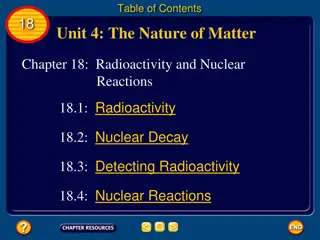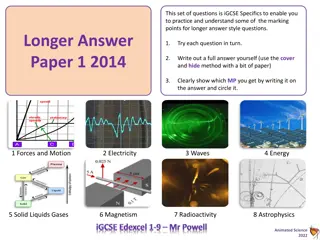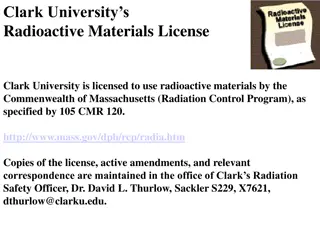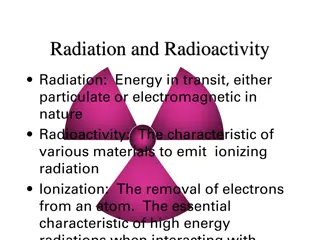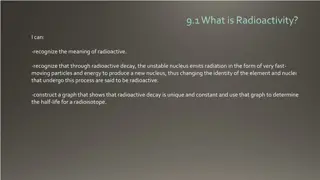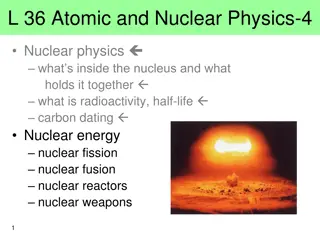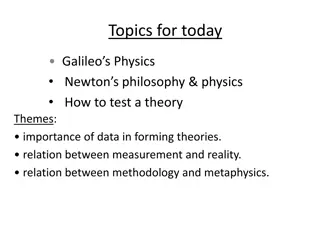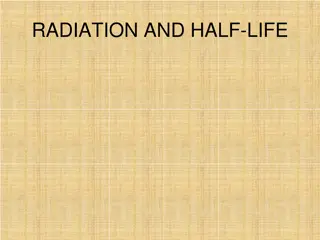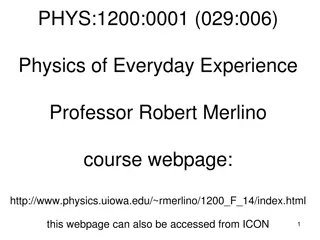Understanding Radioactivity in Modern Physics
Radioactivity is the spontaneous emission of radiation by unstable atomic nuclei, seeking a more stable configuration. It can be measured using the becquerel as the SI unit, with factors determining nuclear stability being neutron/proton ratio and number of nucleons. The Law of Radioactive Decay explains the proportional relationship between decaying nuclei and total nuclei in a sample over time.
Download Presentation

Please find below an Image/Link to download the presentation.
The content on the website is provided AS IS for your information and personal use only. It may not be sold, licensed, or shared on other websites without obtaining consent from the author. Download presentation by click this link. If you encounter any issues during the download, it is possible that the publisher has removed the file from their server.
E N D
Presentation Transcript
MODERN PHYSICS R A D I O A C T I V I T Y BY- SUBJECT TEACHER- DR. ANJANI SINGH PUNEET KUMAR RAY RAHUL SHARMA PUNEET MANI TRIPATHI
WHAT IS RADIOACTIVITY? Radioactivity is the act of emitting radiation spontaneously. This is done by an atomic nucleus that, for some reason, is unstable; it "wants" to give up some energy in order to shift to a more stable configuration. HOW IS RADIOACTIVITY MEASURED? It can be measured by counting number of atoms decaying Each second using instruments. SI unit- becquerel i.e. 1 disintegration per second
What factors determine nuclear stability? 1.NEUTRON/PROTON RATIO The principal factor for determining whether a nucleus is stable is the neutron to proton ratio. Graphical example via word file
2.NUMBER OF NUCLEONS No nucleus higher than lead-208 is stable. That's because, although the nuclear strong force is about 100 times as strong as the electrostatic repulsions, it operates over only very short distances. When a nucleus reaches a certain size, the strong force is no longer able to hold the nucleus together.
LAW OF RADIOACTIVE DECAY- The number of nuclei undergoing the decay, per unit time, is proportional to the total number of nuclei in the sample material. Mathematical Derivation- If N = total number of nuclei in the sample and N = number of nuclei that undergo decay in time t then, N/ t N Or, N/ t = N (1) where = radioactive decay constant or disintegration constant. Now, the change in the number of nuclei in the sample is, dN = N in time t. Hence, the rate of change of N (in the limit t 0) is, dN/dt = N Or, dN/N = dt
Now, integrating both the sides of the above equation, we get, NN0 dN/N = tt0 dt (2) Or, ln N ln N0= (t t0) (3) Where, N0is the number of radioactive nuclei in the sample at some arbitrary time t0and N is the number of radioactive nuclei at any subsequent time t. Next, we set t0= 0 and rearrange the above equation (3) to get, ln (N/N0) = t Or, N(t) = N0e t (4) Equation (4) is the Law of Radioactive Decay.
Or, dN/N = dt Now, integrating both the sides of the above equation, we get, NN0 dN/N = tt0 dt (2) Or, ln N ln N0= (t t0) (3) Where, N0is the number of radioactive nuclei in the sample at some arbitrary time t0and N is the number of radioactive nuclei at any subsequent time t. Next, we set t0= 0 and rearrange the above equation (3) to get, ln (N/N0) = t Or, N(t) = N0e t (4) Equation (4) is the Law of Radioactive Decay.
The Decay Rate- This rate gives us the number of nuclei decaying per unit time. MATHEMATICAL DERIVATION FOR DECAY RATE- Let s say that we consider a time interval dt and get a decay count N (= dN). The decay rate is now defined as, R = dN/dt Differentiating equation (4) on both sides, we get, R = N0e t Or, R = R0e t (5) Where, R0is the radioactive decay rate at the time t = 0,
and R is the rate at any subsequent time t. Equation (5) is the alternative form of the Law of Radioactive Decay. Now we can rewrite equation (1) as follows, R = N (6) where R and the number of radioactive nuclei that have not yet undergone decay must be evaluated at the same instant. Half-Life and Mean Life Half-life T1/2 the time at which both R and N are reduced to half of their initial values Mean life the time at which both R and N have been reduced to, e-1of their initial values.
Calculating Half-Life Finding the relation between T1/2 and the disintegration constant . For this, let s input the following values in equation (5), R = (1/2)R0 and t = T1/2 So, we get T1/2 = (ln2)/ Or, T1/2 = 0.693/ (7) Calculating Mean life Next, let s find the relation between the mean life and the disintegration constant . For this, let s consider equation (5), The number of nuclei which decay in the time interval: t to t + t is: R(t) t = ( N0e t t).
Each of them has lived for time t. Hence, the total life of all these nuclei is t N0e t t Hence, to obtain the mean life, we integrate this expression over all the times from 0 to and divide by the total number of nuclei at t = 0 (which is N0). = ( N0 0 te^( t)dt)/N0 = 0 te tdt On solving this integral, we get = 1/ Therefore, we can summarise the observations as follows: T1/2 = (ln2)/ = ln 2 (8)
Solved Examples Question: The half-life of 23892U undergoing -decay is 4.5 109 years. What is the activity of 1g sample of 23892U ? Answer: T1/2 = 4.5 x 109 years = 4.5 x 109years x 3.6 x 107 seconds/year = 1.42 x 1017 seconds We know that 1 k mol of any isotope contains Avogadro s number of atoms. Hence, 1g of 23892U contains, {1/(238 x 10-3)} x 6.025 x 1026 = 25.3 x 1020 atoms. Therefore, the decay rate R is, R = N = (0.693/T1/2)N = (0.693 x 25.3 x 1020) / (1.42 x 1017) Therefore, R = 1.23 x 104 Bq
There are three types of radioactive decays in nature: -decay a helium nucleus (42He) is emitted with energy 5 MeV -decay where electrons or positrons (particles with the same mass as, but with a charge exactly opposite to that of an electron) are emitted Energy released 1 MeV, but can range from a few keV to a few tens of MeV. -decay high energy (hundreds of keV or more) photons are emitted.
How to identify ,, radiation
Paulis Prediction In 1930 the Austrian physicist Wolfgang Pauli predicted that there must be another particle given off when a beta particle is produced, which is very difficult to detect. The Italian physicist Enrico Fermi named it the 'neutrino', which means little neutral one in Italian. Pauli suggested that the energy liberated in beta decay was shared in a random way between the beta particle and the neutrino. This would account for the range of observed energies of beta particles and the different angles at which a nucleus could recoil.
Relativistic Photon Momentum There is a relationship between photon momentum p and photon energy E that is consistent with the relation given previously for the relativistic total energy of a particle as E^2 = (pc)^2 + (mc)^2. We know m is zero for a photon, but p is not, so that E^2 = (pc)^2 + (mc)^2 becomes E = pc, or p=E/c (photons). To check the validity of this relation, note that E=hc/ , E=hc/ for a photon. Substituting this into p=E/c or p=Ec yields p=(hc/ )/c=h/
Pair production- in physics, formation or materialization of two electrons, one negative and the other positive (positron), from a pulse of electromagnetic energy traveling through matter, usually in the vicinity of an atomic nucleus. It is one of the principal ways in which high-energy gamma rays are absorbed in matter. The mass m of a single electron is equivalent to 0.51 million electron volts (MeV) To produce two electrons photon energy must be at least 1.02 MeV. Photon energy in excess of this amount, when pair production occurs, is converted into motion of the electron-positron pair.
Internal pair production,a species of gamma decay (q.v.), occurs when an unstable nucleus that has at least 1.02 MeV of excess energy directly ejects an electron-positron pair created within its own electromagnetic field without first producing a gamma photon.


